The expansion of early learning and childcare: evaluation report 2017
A report exploring the impact of the expansion of government-funded early learning and childcare after 2014.
This document is part of a collection
7. Use of the ELC entitlement
Key findings
Registrations for funded ELC
- Since 2012, almost all eligible 3 and 4 year old children have been registered to use their funded ELC entitlement (99%), but estimates suggest that just over a third of eligible 2 year olds are.
- A proportion of the eligible parents who do not use funded ELC say this is because of personal preferences (e.g. because they think their child is too young). But another proportion mentions barriers, such as that they were not aware of the entitlement, don't know how to apply, or are not able to access available or sufficiently flexible providers.
- Since 2012, around three quarters of ELC registrations have been with a local authority provider and around a quarter with a partner provider.
- Most eligible children attend a nursery with proportionately small numbers using a childminder, playgroup or other form of ELC.
Average hours used
- Comparing the six months immediately before and after the expansion to 600 hours in 2014, the average number of funded ELC hours parents report using for their 4 year old child increased by just over 1.5 hours per week.
- It is estimated that currently, parents who use the funded entitlement on average use 29 hours per week of regular childcare for 3 and 4 year olds (14 funded, 7 paid and 8 informal), and 25 hours per week for 2 year olds (13 funded, 3 paid and 9 informal).
- Around half of 3 and 4 year olds and around a third of eligible 2 year olds currently use 30 hours or more of regular childcare (including funded, privately paid and informal childcare).
- Around three quarters of parents with eligible children use funded ELC in combination with paid and/or regular informal provision. Only 16% of eligible parents use funded ELC only.
Expected use of the 1140 hours funded entitlement
- 75% of parents with children below six say they would use all or almost all of the future 1140 hours for a 3 or 4 year old if it offered the flexibility they needed, and 67% for a 2 year old.
- On average, expected use of the future 1140 hours is highest amongst parents who currently already use 30 hours or more per week, who currently pay for ELC, who currently experience difficulties affording ELC, and two-earner households.
In order for the ELC expansion policy to achieve its long-term aims, it is important that parents of eligible children take up the available funded ELC.
Funded provision of ELC is offered to all 3 and 4 year olds, as well as eligible 2 year olds (estimated to be around a quarter of all 2 year olds). 2 year olds are eligible if their parents are in receipt of qualifying benefits. 2 year olds who are (or have since turning 2 been) looked after by a local authority, the subject of a kinship care order, or have a parent-appointed guardian are also entitled to funded ELC. [41]
This chapter provides evidence on the current and past uptake of the ELC entitlement as well as other regular childcare, parents' reasons for not taking up the entitlement, and parents' views on whether they would use the 1140 hours funded ELC. As such it aims to explore changes in uptake of the entitlement after the expansion in 2014; provide a baseline for monitoring changes in ELC use as the expansion to 1140 is being rolled out; and provide learning to support the implementation of the 1140 hours expansion.
Current use
Current use of the early learning and childcare entitlement
Almost all 3 and 4 year olds in Scotland use their ELC entitlement either in full or in part, but use amongst eligible 2 year olds is much lower. Figure 21 below shows the estimated percentage of 2, 3 and 4 year old children [42] in Scotland registered for funded ELC over time, as published in the Scottish Government's annual Summary Statistics for Schools in Scotland publication. [43]
From 2015 improvements to the data collection were made. In particular, the recording of children aged under 3 has improved as previously children who were not receiving funded ELC but were attending centres had been wrongly included by centres. This means that pre-2015 figures are likely overestimates and that accurate comparisons with before and after 2015 cannot be made.
Figure 21: Percentage of children registered for funded ELC
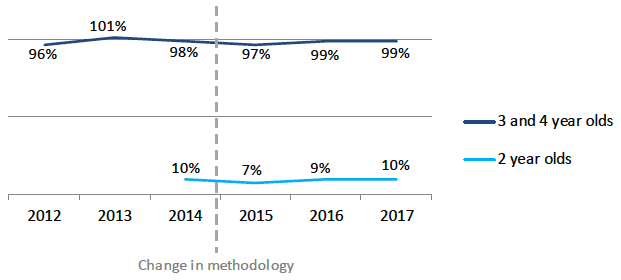
Figure 21 shows the percentage of all 2 year olds registered for funded ELC. However, not all 2 year olds are eligible for funded ELC. In 2014 around 15% of 2 year olds became eligible and in 2015 eligibility criteria were further extended which led to around a quarter of 2 year olds in Scotland being eligible for funded ELC.
Estimates suggest that of all 2 year olds eligible for funded ELC, just over a third uses the entitlement.
While the percentage of eligible children registered slightly increased between 2015 and 2017, the total number of children registered at the time of the ELC census, held in September, fell slightly, by 1.4% from 97,262 in 2015 to 95,893 in 2017. This is because the total population of pre-school age children in Scotland has decreased since 2015.
Local authority and partner providers
The ELC entitlement is offered in local authority-run settings, but also in private or voluntary providers who are in a partnership with local authorities. Over the past years around three quarters of ELC registrations were with a local authority provider and around a quarter with a local authority partner provider, as shown in figure 22 below. [44]
Figure 22: Percentage of funded ELC registrations in local authority settings and partner providers

As shown in chapter 2 on capacity, within these national figures, there are differences between local authorities, with some making significantly more use of partner providers than others.
Types of formal early learning and childcare provision
The 2017 ELC parent survey asked for details on the types of formal ELC eligible children had attended in the last 12 months. This showed that most eligible children attend a nursery and proportionately fewer another form of ELC provision, as shown in figure 23:
Figure 23: types of formal ELC attended by eligible children in the past 12 months (2017 ELC Parent Survey)
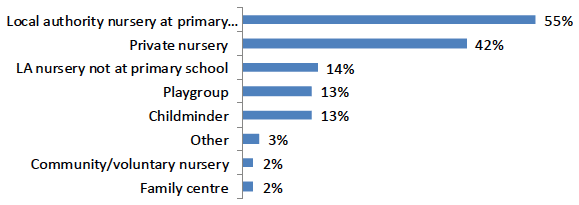
Figure 23 also indicates that some children attend more than one type of early learning and childcare provider. This may include parents who supplement the funded ELC hours with privately paid childcare at a different provider, parents who use more than one provider for the funded hours and parents who use more than one provider for privately paid ELC.
Hours used and combining funded, paid and informal early learning and childcare
While the previous sections show the percentage of eligible children registered for ELC, this does not indicate how many hours they use. In 2014 the funded ELC entitlement was expanded from 475 to 600 hours per year. Analysis of data from the Growing Up in Scotland ( GUS) study [45] suggests that this expansion may indeed have led to an increase in the hours parents use. Comparing the six months before and six months after the increase in funded ELC entitlement in August 2014, the analysis showed an increase of just over 1.5 hours per week in the average number of hours parents reported their 4 year olds spent at their main ELC provider: [46]
Figure 24: average weekly hours 4 year olds attended their main funded ELC provider in the 6 months immediately before and after the increase in funded ELC entitlement in August 2014 (Growing Up in Scotland)

The 2017 ELC parent survey shows that the majority of parents with eligible children (2, 3 and 4 year olds) use funded ELC in combination with regular paid and/or informal provision (e.g. relatives providing regular childcare):
73% of parents of eligible children use funded hours in combination with privately paid and/or informal
16% use funded ELC only
59% of parents of eligible children use privately paid early learning and childcare (52% alongside funded provision, 3% alongside informal provision and 4% use privately paid ELC only)
The 2017 ELC parent survey also explored the number of hours parents of eligible children use funded ELC, as well as the number of hours they use paid and informal regular childcare. This showed that for 3 and 4 year old children, parents who use ELC report to use on average 29 hours of regular early learning and childcare: 14 of which are funded, 7 privately paid and 8 informal. For 2 year old children, parents of eligible children on average use 25 hours regular childcare: 13 funded, 3 privately paid and 9 informal.
Figure 25: Average weekly hours of funded, privately paid and regular informal ELC use per child reported by parents who use some form of ELC (2017 ELC Parent Survey)
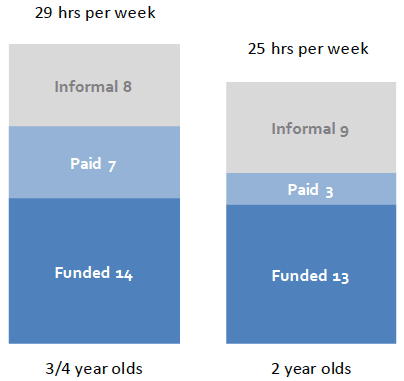
Figure 26 below gives more detail on the total average weekly hours of regular ELC used (funded, paid and informal). It shows that roughly a third of both eligible 2 year olds and eligible 3 and 4 year olds on average use 16 to 29 hours of ELC per week. But amongst 3 and 4 year olds half use 30 hours or more [47] and only 15% use less than 16 hours. Amongst 2 year olds 34% use 30 hours or more and 32% less than 16 hours.
Figure 26: Weekly hours of ELC use (funded, privately paid and informal) per child reported by parents who use some form of ELC (2017 ELC Parent Survey)
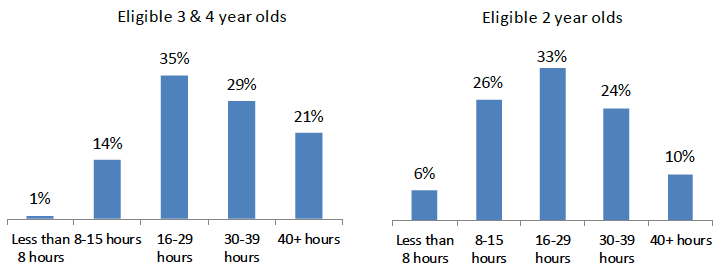
On average, parents with higher household incomes use more hours of ELC than parents with lower household incomes. Looking at all types of regular ELC (funded, privately paid and informal), parents with an annual household income of at least £60,000 on average use 33 hours per week, compared to 25 hours per week for parents with a household income of less than £16,000:
Figure 27: Average weekly hours of ELC use (funded, privately paid and regular informal) per child, by average household income (2017 ELC Parent Survey)

The proportion [48] of parents who said they do not take up any of their funded hours of ELC were asked for their reasons for this. Not wanting to use the entitlement was mentioned by a proportion of those parents (either because they feel their child is too young or because they want to look after their child themselves.) Several of the other reasons mentioned by parents were about facing barriers to using the entitlement: either that they were not aware of the entitlement, don't know how to apply, or are not able to access available providers or sufficiently flexible providers.
The most frequently mentioned reasons for not taking up any of the ELC entitlement were: [49]
For eligible 3 and 4 year old children:
1. I think my child is too young (22% of parents who don't use the entitlement)
2. I was not aware of the availability of funded childcare (22%)
3. I want to look after my child myself most of the time (17%)
4. A lack of flexibility or choice in available opening hours (15%) or types of childcare settings (14%)
5. I don't know how to apply for funded childcare/I find applying too difficult (15%)
For eligible 2 year old children:
1. I think my child is too young (24% of parents who don't use the entitlement)
2. I was not aware of the availability of funded childcare (22%)
3. No reason/I don't know (22%)
4. There are no available providers near me (21%)
5. A lack of flexibility or choice in available opening hours (19%)
The fact that not being aware of the availability of funded childcare was one of the most frequently mentioned reasons for not taking up the entitlement corresponds to findings from earlier qualitative research.
The Scottish Government commissioned research in late 2016 to examine factors that were affecting the uptake of funded ELC for 2 year olds. While this qualitative research was not representative for all parents of eligible 2 year olds in Scotland, it gave an indication that a number of parents interviewed did not take up the ELC entitlement for their 2 year old because they were unaware of the entitlement. When those parents were told about it during the interview, many of them reacted positively and it was suggested that some of them would have used it had they known about it. [50]
The large majority of parents who do take up the entitlement were asked for their main reasons for using ELC. This will be discussed in chapter 8.
Future use of the 1140 hours ELC entitlement
The 2017 ELC parent survey asked parents of children below 6 how much of the 1140 hours they might use if it offered the flexibility they needed and were available now and they had an eligible 3 or 4 year old. Of the parents who felt able to respond to this question: [51]
75% said they would use all or almost all of the 1140 hours
15% said they would use some but not all of the additional hours on top of the current 600 hours entitlement
10% said they wouldn't use any of the additional entitlement
The percentage of parents who thought they would use the additional funded hours if it offered the flexibility they needed for eligible 2 year old children was lower, but still substantial:
67% said they would use all or almost all of the 1140 hours
15% said they would use some but not all of the additional hours on top of the current 600 hours entitlement
18% said they wouldn't use any of the additional entitlement
Amongst parents in the lowest income category (below £16,000), who are most likely to be eligible for ELC when their child is two, this was broadly the same with 67% saying they would take up all or almost all of the 1140 hours and 19% that they would use some of the additional entitlement.
The expected uptake of the 1140 hours is also broadly the same for parents in different areas of multiple deprivation ( SIMD), parents living in different urban/rural areas and parents with and without children with additional support needs.
However, there is some variation across parent groups in the extent to which parents say they would use the expanded entitlement, which relates primarily to parents' current use of ELC, and factors such as how much parents currently spend on their provision and employment.
The following factors are most strongly related to whether parents say they would take up the 1140 funded hours: [52]
1. The number of hours of ELC parents currently use: parents currently using 16 or more hours per child per week, and particularly those using 30 or more hours are significantly more likely to take up the 1140 hours
2. Whether and how much parents currently pay for provision: parents who currently pay are most likely to take up the 1140 hours, especially those who pay £1000 or more per month
3. Experience of difficulties affording the cost of ELC: parents who have experienced some degree of difficulty in the last 12 months are most likely to take up the 1140 hours;
4. The number of adults in employment: two earner households are most likely to take up the 1140 hours.
Reasons for not using all of the 1140 hours
The parents who said they would use only part of the funded 1140 entitlement for one or more of their children (15% of all parents with children below 6) were asked what would prevent them from using the full entitlement. Parents could choose multiple reasons. The most frequently mentioned reasons were not needing or wanting childcare for so many hours, and a feeling that children should not be in nursery for that long:
Figure 30: reasons reported by parents for wanting to use only part of the funded 1140 entitlement if it were available now and provided the flexibility needed (2017 ELC parent survey)
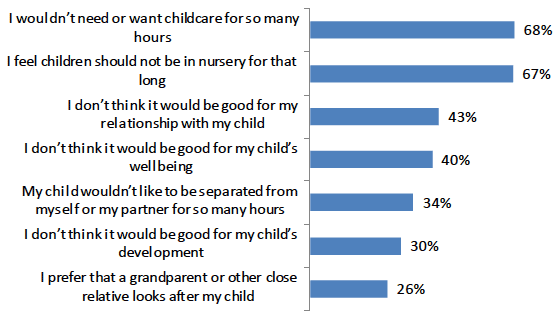
Amongst parents who said they would not use any of the additional entitlement for one or more of their children (10% for 3 and 4 year old children, 18% for 2 year old children) the most frequently mentioned reason was that they want to look after their children themselves most of the time:
Figure 31: reasons reported by parents for not wanting to use any of the funded 1140 entitlement if it were available now and provided the flexibility needed (2017 ELC parent survey)
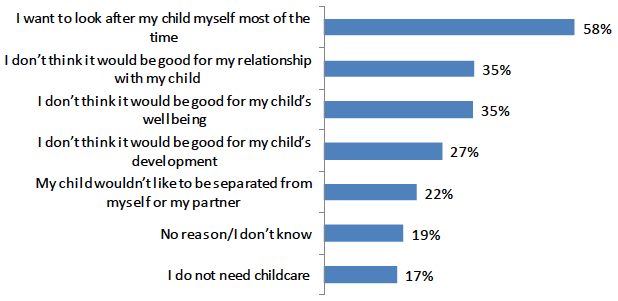
Encouraging use of the 1140 hours: learning from the ELC trials programme
Since late 2016, the Scottish Government has funded trials in 14 local authorities across Scotland, to test out different ways in which the 1140 hours can be delivered and gather learning to help the expansion across Scotland. This trials programme is still ongoing and findings will be reported in summer 2018. In summer 2017 initial learning was gathered through structured conversations with leads of the trials on a number of themes. One of these themes was what had so far worked well and what less well in encouraging parents to take up the funded 1140 hours offered, especially for eligible two year olds. Learning on this included:
What worked well for encouraging parents to use the 1140 hours offered
- Personal contact with parents: having face-to-face conversations with parents about the offer on a one-to-one basis, and building personal relationships. For example, the lead of one of the trials commented " This needs to be done by sitting down with them in a room and building trust. What worked well was the face-to-face contact, not just sending a letter. This takes time but it is worth it."
- Working in partnership with other services and stakeholders, to understand how best to communicate the offer to parents and help reach parents. For example, one trials lead said "Involving the local activist was useful - she knew all of the families who came forward and could provide insight into their circumstances"
What did not work well for encouraging parents to use the 1140 hours offered
- Formal ways of communicating. Comments included for example: " setting up semi-formal information sessions was not the best way to proceed. Some parents were very anxious and lacking confidence about coming to a meeting and what might be expected … it would have been better to engage more informally at nurseries or other groups already used by parents" and " Not necessarily all families are literate, though most are; it tends to be the talk that follows. Next time we'd try different methods of communication … a meeting with parents in addition to the written information".
- Parents not fully understanding the offer: a number of trials reported initial misunderstandings about the offer, and having learned that more clarity needs to be provided. Misunderstandings included for example parents not being aware of the eligible funding available for two year olds, not being familiar with the term 'early learning and childcare', not understanding different flexibility options, and thinking that if they sign up for additional hours it is mandatory to use the full 1140 hours all the time.
Contact
There is a problem
Thanks for your feedback